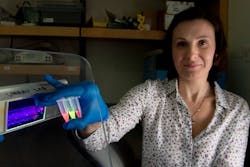Fluorescence imaging technology could help develop Coronavirus testing kits
A team of researchers at Simon Fraser University (SFU; Burnaby, BC, Canada) will use a fluorescence imaging technology to develop Coronavirus testing kits. The group is among a small set of Canadian researchers who responded to the rapid funding opportunity recently announced by the Canadian Institutes of Health Research (CIHR) to help address the virus, formally known as COVID-19.
SFU researchers Lena Dolgosheina, a postdoctoral fellow and Peter Unrau, a professor of molecular biology and biochemistry, developed the technology, called Mango, to sensitively detect RNA molecules, helping to improve viral screening for viruses such as the Coronavirus while enabling basic discoveries into the functioning of cells. The latest research, led by Unrau, involves using Mango to detect individual molecules of RNA within a living cell.
“We are made of molecules so when something goes wrong within a cell it happens at the molecular level, says Unrau. “We are using the Mango system as a catalyst, to allow us to not only extend fundamental research questions but also to detect pathogens like the Coronavirus, faster and more efficiently.”
The Mango system consists of an RNA Mango aptamer that binds tightly and specifically to a fluorescent dye. The aptamer acts like a magnet, targeting and binding those dye molecules. The dye becomes excitable when bound and glows brightly. RNA molecules modified to contain the aptamer 'magnet' now stand out from the other parts of the cell, which makes it much easier for researchers to see and study RNA molecules under a microscope.
“Cell regulation takes place at the level of RNA,” Unrau says. “For a long time, the focus has been on protein but it is RNA and not protein that regulates the vast majority of processes within a cell.”
RNA Mango dyes are currently available from Applied Biological Materials (ABM; Richmond, BC, Canada). The Coronavirus research made possible by CIHR funding will allow the team to develop an isothermal testing methodology, known as Mango NABSA (nucleic acid sequence-based amplification).
The Mango NABSA kits can be used to test for the Coronavirus, which is a positive strand RNA virus. ABM is actively involved with this project as a partner and will supply the enzymes and buffers needed, which the SFU team originally developed.
Full details of the work appear in the journal Nature Communications.
